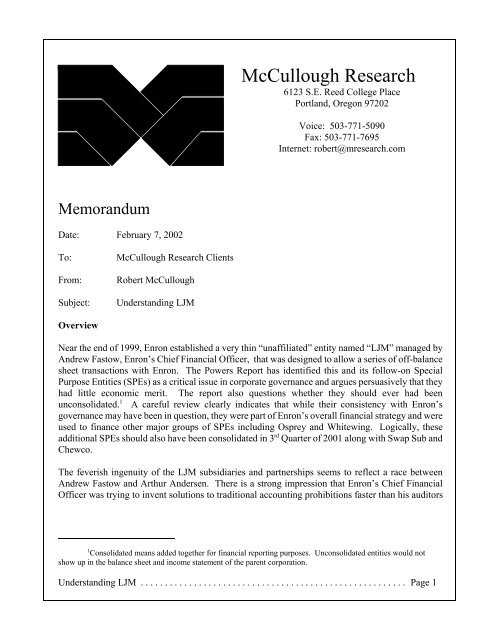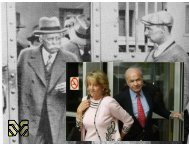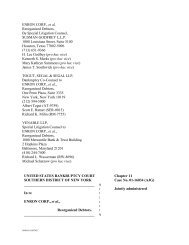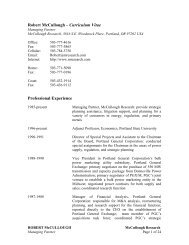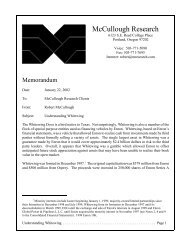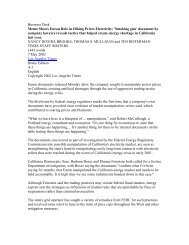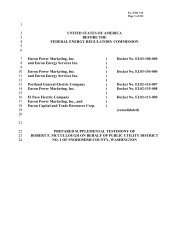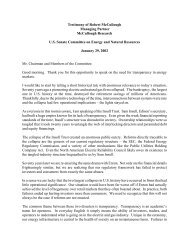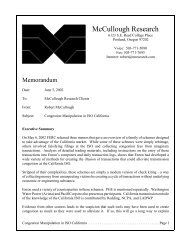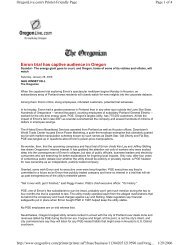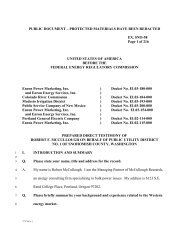Understanding LJM - McCullough Research
Understanding LJM - McCullough Research
Understanding LJM - McCullough Research
Create successful ePaper yourself
Turn your PDF publications into a flip-book with our unique Google optimized e-Paper software.
<strong>McCullough</strong> <strong>Research</strong><br />
6123 S.E. Reed College Place<br />
Portland, Oregon 97202<br />
Voice: 503-771-5090<br />
Fax: 503-771-7695<br />
Internet: robert@mresearch.com<br />
Memorandum<br />
Date: February 7, 2002<br />
To:<br />
From:<br />
Subject:<br />
<strong>McCullough</strong> <strong>Research</strong> Clients<br />
Robert <strong>McCullough</strong><br />
<strong>Understanding</strong> <strong>LJM</strong><br />
Overview<br />
Near the end of 1999, Enron established a very thin “unaffiliated” entity named “<strong>LJM</strong>” managed by<br />
Andrew Fastow, Enron’s Chief Financial Officer, that was designed to allow a series of off-balance<br />
sheet transactions with Enron. The Powers Report has identified this and its follow-on Special<br />
Purpose Entities (SPEs) as a critical issue in corporate governance and argues persuasively that they<br />
had little economic merit. The report also questions whether they should ever had been<br />
unconsolidated. 1 A careful review clearly indicates that while their consistency with Enron’s<br />
governance may have been in question, they were part of Enron’s overall financial strategy and were<br />
used to finance other major groups of SPEs including Osprey and Whitewing. Logically, these<br />
additional SPEs should also have been consolidated in 3 rd Quarter of 2001 along with Swap Sub and<br />
Chewco.<br />
The feverish ingenuity of the <strong>LJM</strong> subsidiaries and partnerships seems to reflect a race between<br />
Andrew Fastow and Arthur Andersen. There is a strong impression that Enron’s Chief Financial<br />
Officer was trying to invent solutions to traditional accounting prohibitions faster than his auditors<br />
1 Consolidated means added together for financial reporting purposes. Unconsolidated entities would not<br />
show up in the balance sheet and income statement of the parent corporation.<br />
<strong>Understanding</strong> <strong>LJM</strong> ....................................................... Page 1
could understand and apply them. 2<br />
While Andrew Fastow’s involvement with <strong>LJM</strong> may well be questionable, the presence of Jeff<br />
Skilling at the October 26, 2000 <strong>LJM</strong> Annual Partner’s Meeting clearly indicates the participation and<br />
concurrence of senior management. 3 Although the Powers Report focuses on violations of Enron’s<br />
ethical code, the sheer complexity and scale of the <strong>LJM</strong> transactions indicates that Andrew Fastow<br />
was pursuing Enron’s corporate goals. Simple self-dealing could have been achieved vastly more<br />
quickly and safely than the creation of the many questionable SPEs and the involvement of numerous<br />
limited partners.<br />
<strong>LJM</strong> was an extraordinary investment opportunity. Information provided to <strong>LJM</strong>’s investors appears<br />
to contain an enormously more detailed description of Enron’s actual financial situation than that<br />
provided through Enron’s annual reports, 10Ks, and 10Qs. 4 In addition, the financial opportunities<br />
available to the investors range from 12% to 2503% with an overall forecasted internal rate of return<br />
of between 51% and 69%. To quote the Powers Report:<br />
There were several direct consequences of this failure: transactions were executed on<br />
terms that were not fair to Enron and that enriched Fastow and others; Enron engaged<br />
in transactions that had little economic substance and misstated Enron's financial<br />
results; and the disclosures Enron made to its shareholders and the public did not fully<br />
or accurately communicate relevant information. 5<br />
Our review of <strong>LJM</strong> indicates that this well may be an understatement. It is difficult to understand the<br />
financing pressures that must have existed on Enron’s management to have participated in any fashion<br />
with a financing vehicle whose returns – and therefore, costs, to Enron – were so high.<br />
In the absence of <strong>LJM</strong> and other financing mechanisms like Chewco and Whitewing, it is very likely<br />
2 Proper financial accounting does not permit this result. To reach it, the accountants at Enron and<br />
Andersen--including the local engagement team and, apparently, Andersen's national office experts in Chicago--had<br />
to surmount numerous obstacles presented by pertinent accounting rules. Powers Report, page 129.<br />
3<br />
October 26, 2000 <strong>LJM</strong> Annual Partner’s Meeting, page 2. While the vast majority of materials used in this<br />
report are standard SEC filings and reports such as the Powers Report, this document has been obtained from<br />
Matthew Goldstein, a senior Wall Street correspondent at SmartMoney.com. A careful review of the document<br />
makes it clear that it is not simply the product of a malicious prankster. The materials show a level of detail, that if<br />
false, would require an expert insider’s hand. Given the timing of the document and the level of detail, it appears to<br />
be genuine and has been treated so in this report.<br />
4 October 26, 2000 <strong>LJM</strong> Annual Partner’s Meeting, page 8.<br />
5<br />
Powers Report, page 19.<br />
<strong>Understanding</strong> <strong>LJM</strong> ....................................................... Page 2
that Enron’s actual operations lost money over the past five quarters. 6 The scale of earnings from<br />
these special transactions seemingly explains almost all of Enron’s profits, bring into question the<br />
profitability and viability of Enron’s trading operation.<br />
Hedging<br />
After a careful reading of the Powers Report and <strong>LJM</strong> documents, the term “hedging” begins to seem<br />
very ambiguous indeed. The colloquial phrase “hedging your bets” comes from John Donne whose<br />
sermon over four hundred years ago includes the words “All your hedging in off debts/all your crafty<br />
bargains.” While Enron’s use of the phrase may be closer to John Donne’s meaning than today’s, the<br />
original sense was that a farmer would plant a hedge around his fields to protect vulnerable livestock.<br />
Today, we can purchase a hedge that will protect us from bad markets in a specific asset.<br />
The key, however, is that we cannot hedge an investment with ourselves. The fundamental<br />
transaction involves purchasing the hedge from another party who will bear our risk for a fee.<br />
Throughout Enron’s SPEs the term hedge is generally misused. Enron’s “hedges” at Raptors 1, 2, and<br />
4, were simply a vehicle for gaining the benefits from expected appreciation of Enron stock. Raptor<br />
3's “hedge” was in the same stock that was being hedged – a sophisticated version of taking in your<br />
own washing.<br />
Background<br />
On June 18, 1999, Andrew Fastow proposed a novel financing mechanism to Ken Lay and Jeff<br />
Skilling. 7 The concept was presented to the Board on June 28, 1999. 8 In the Board presentation,<br />
Fastow offered to invest $1 million in the new SPE.<br />
In November 1999 Andrew Fastow established <strong>LJM</strong> Cayman (<strong>LJM</strong>1). “<strong>LJM</strong>”, which stands for the<br />
initials of its Andrew Fastow’s wife and children, was unique in that its General Partner was also<br />
Enron’s Chief Financial Officer. 9 <strong>LJM</strong>’s limited partners were Greenwich Natwest and Credit Suisse.<br />
6<br />
Nonetheless, if one were to subtract from Enron's earnings the $1.1 billion in income (including interest<br />
income) recognized from its transactions with the Raptors, Enron's pre-tax earnings for that period would have been<br />
$429 million, a decline of 72%. Powers Report, page 99. Since the Powers Report does not consider the unwinding<br />
of Whitewing and its purchase of faltering Enron assets like Elektro, the total may well be much larger.<br />
7<br />
Powers Report, page 68.<br />
8 Powers Report, page 69.<br />
9<br />
Corporate Veil: Behind Enron's Fall, A Culture of Operating Outside Public's View --- Hidden Deals With<br />
Officers And Minimal Disclosure Finally Cost It Its Trust --- Chewco and JEDI Warriors, Wall Street Journal,<br />
12/05/2001.<br />
<strong>Understanding</strong> <strong>LJM</strong> ....................................................... Page 3
Andrew Fastow owned 6% of <strong>LJM</strong> Cayman and the limited partners owned the remaining 94%. 10<br />
Total capitalization was $1 million from Fastow and $15 million from the two limited partners.<br />
The fundamental objective of this and similar SPEs was their ability to do business with Enron “off<br />
the balance sheet.” This term does not do the arrangements justice, however. The existence of <strong>LJM</strong><br />
did more than hide balance sheet items from investors.<br />
When <strong>LJM</strong> purchased a share of the Cuiaba power project from Enron for $11.3 million in September<br />
1999, it allowed Enron to deconsolidate the natural gas supply arrangements for the plant. This, in<br />
turn, allowed Enron to recognize earnings of $65 million dollars for sales to Cuiaba for natural gas<br />
on a mark-to-market basis. 11 This is in spite of the fact that the plant still does not have access to<br />
natural gas today. 12 After the earnings were taken, the share of Cuiaba was later repurchased by<br />
Enron. While the use of mark-to-market by Enron has been aggressive, this is a case of clear abuse<br />
– mark-to-market treatment of a transaction between different parts of Enron for a product that could<br />
not been delivered at values that cannot be verified.<br />
It would never have been possible for even the savviest investor to have evaluated the significance<br />
of these “earnings.” For example, the 1998 10K indicates a 65% direct ownership while later<br />
financial reports simply footnote that “Enron holds varying interests in these projects.” 13<br />
The significance of Cuiaba and similar transactions is that they had a major impact on Enron’s income<br />
statement as well. The Powers Report describes the income state impact of the Raptor SPEs as: 14<br />
10 To our knowledge, <strong>LJM</strong> is a wholly-owned subsidiary of <strong>LJM</strong> Cayman, L.P. To our knowledge,<br />
Greenwich Natwest and Credit Suisse collectively own a 94% interest in <strong>LJM</strong> Cayman, L.P., and an individual owns<br />
a 6% interest. SEC Form U-57/A, 10/20/2000.<br />
11<br />
In September 1999, Enron sold <strong>LJM</strong>1 a 13% stake in a company building a power plant in Cuiaba, Brazil.<br />
This was the first transaction between Enron and <strong>LJM</strong>1 after the Rhythms hedge. This sale, for approximately $11.3<br />
million, altered Enron's accounting treatment of a related gas supply contract and enabled Enron to realize $34<br />
million of mark-to-market income in the third quarter of 1999, and another $31 million of mark-to-market income in<br />
the fourth quarter of 1999. In August 2001, Enron repurchased <strong>LJM</strong>1's interest in Cuiaba for $14.4 million. Powers<br />
Report, page 135.<br />
12 11/19/2001, Electric Utility Week, page 24.<br />
13 March 18, 1999 Form 8-K. The 1999 Annual Report makes no mention of Cuiaba’s ownership at all.<br />
14<br />
Powers Report, page 133.<br />
<strong>Understanding</strong> <strong>LJM</strong> ....................................................... Page 4
Earnings<br />
Earnings<br />
Without<br />
Raptors<br />
Raptors'<br />
Contribution To<br />
Earnings<br />
3Q 2000 $364 $295 $69<br />
4Q 2000 $286 ($176) $462<br />
1Q 2001 $536 $281 $255<br />
2Q 2001 $530 $490 $40<br />
3Q 2001 ($210) ($461) $251<br />
Total $1,506 $429 $1,077<br />
For analysts, like ourselves, who are trying to determine whether Enron Wholesale Services Americas<br />
were profitable without these income statement adjustments, this is very important. The clear<br />
implication is that Enron’s stated profits were mainly accounting fiction and that the trading<br />
operations were not making a significant contribution to the bottom line.<br />
An additional major question is whether <strong>LJM</strong> should have been consolidated with Enron. Arthur<br />
Andersen has taken the position that a part of <strong>LJM</strong>, Swap Sub, should have been consolidated because<br />
it failed to meet the 3% technical standard for non-consolidation.<br />
The Powers Report is less clear concerning consolidation of <strong>LJM</strong>1 and its follow on SPE, <strong>LJM</strong> Co-<br />
Investment L.P. (<strong>LJM</strong>2). The technical requirements that there was 3% outside equity at risk appears<br />
to have been met by both <strong>LJM</strong>1 and <strong>LJM</strong>2. At issue is whether Andrew Fastow, as an Enron officer,<br />
controlled <strong>LJM</strong>1 and <strong>LJM</strong>2. A final answer to this argument must necessarily await the detailed<br />
investigation at the SEC.<br />
While we wait for the expert opinion of the SEC, it is possible to make a very strong argument that<br />
these entities never met the control test for avoiding consolidation. Not only does the Powers Report<br />
provide the raw materials for this argument, but the materials from the <strong>LJM</strong> Annual Meeting also<br />
provide strong evidence for consolidation.<br />
The Powers Report argues that they cannot determine the degree of Andrew Fastow’s control given<br />
our current knowledge of the structure of <strong>LJM</strong>1 and <strong>LJM</strong>2. 15 While correct, it neglects to recognize<br />
that in the absence of Fastow’s control there was no reason for either <strong>LJM</strong>1 or <strong>LJM</strong>2 to exist.<br />
The raison d’etre of these two SPEs was the ability of a senior Enron executive to position Enron<br />
assets and financial requirements with the assistance of third party equity. In the absence of Andrew<br />
Fastow, the relationship could not have taken place. If the limited partners ousted Andrew Fastow,<br />
the connection that provided potential for profit would be severed. The bottom line is that the absence<br />
of an arm’s length negotiating relationship appears critical to the success of the venture.<br />
15 We have reviewed these issues in detail, and have concluded that there are no clear answers under<br />
relevant accounting standards. Fastow declined to speak with us about these issues. As we have noted, the limited<br />
partners of both <strong>LJM</strong>1 and <strong>LJM</strong>2, citing confidentiality provisions in the partnership agreements, declined to<br />
cooperate with our investigation by providing documents or interviews. Powers Report, page 76.<br />
<strong>Understanding</strong> <strong>LJM</strong> ....................................................... Page 5
The <strong>LJM</strong> Annual Meeting documents make this very clear. The “rationale” of <strong>LJM</strong> was:<br />
! Fund created and managed by the CFO of Enron, Andrew S . Fastow<br />
! Focused on acquiring energy and communications assets primarily owned by Enron 16<br />
Even <strong>LJM</strong>2, the larger and more diversified of the two SPEs, only had 11% of its portfolio<br />
characterized as “Non-Enron”. 17<br />
Regardless of the fine print in the partnership agreements, <strong>LJM</strong> would lose its “rationale” if Fastow’s<br />
control was eliminated. The Fastow link was also important in that it provided a second source of<br />
value for the agreement. Page 8 of the October 26, 2000 meeting provided a detailed annual<br />
breakdown of off-balance sheet assets. Anyone equipped with this information had a far better idea<br />
of the true financial condition of Enron than the investing public. While at this point it is only<br />
speculation, this page provides evidence that the limited partners enjoyed a privileged position with<br />
Enron. 18 This hypothesis is supported by the presence of Jeff Skilling at the meeting – a presence that<br />
the limited partners would interpret as a demonstration of Enron’s commitment to the partnership. 19<br />
<strong>LJM</strong> Cayman<br />
<strong>LJM</strong>1 had three basic transactions with Enron. The first type of transaction was a “hedge” of Enron’s<br />
investment in Rhythms Netconnections. Stripped of the complex web of SPEs that accompanied the<br />
transaction, Enron transferred restricted Enron shares into <strong>LJM</strong> Swap Sub in exchange for a note from<br />
<strong>LJM</strong>1. <strong>LJM</strong> Swap Sub promised to reimburse Enron if the value of its Rhythms Netconnections stock<br />
fell. As the Powers Report notes, this was not a true economic hedge since it depended upon the value<br />
of Enron stock. If Enron stock declined, <strong>LJM</strong> Swap Sub would not be able to perform on its<br />
guarantee to Enron. As we have seen with the Raptors and with Whitewing, the mechanism was a<br />
16<br />
October 26, 2000 <strong>LJM</strong> Annual Partner’s Meeting, page 6.<br />
17 October 26, 2000 <strong>LJM</strong> Annual Partner’s Meeting, page 22.<br />
18 Access to Significant Proprietary Deal Flow. Enron has extensive deal origination capability that is<br />
derived from approximately 2,000 fully dedicated Enron-employed origination and monitoring professionals located<br />
around the world. The deal flow emanating from this origination infrastructure has resulted in Enron making over $7<br />
billion of energy-related investments in each of the last two years and holding merchant investments of over $10<br />
billion. As a result of Enron's in-house deal sourcing capability as well as its leading market position in most<br />
businesses in which it operates, Enron frequently has access to investment opportunities that are not available to<br />
other investors. The Partnership expects to benefit from having the opportunity to invest in Enron-generated<br />
investment opportunities that would not be available otherwise to outside investors . <strong>LJM</strong>2 Private Placement<br />
Memorandum, page 2.<br />
19 Given the extraordinary returns some of the <strong>LJM</strong> investments were making from Enron transactions, the<br />
presence of the president of Enron seems unbelievable unless he was knowledgeable about the relationship. Any<br />
discussion of a 51% rate of return would have led to an immediate replacement of Fastow and renegotiation of the<br />
Enron transactions if Skilling was not a central part of the Enron/<strong>LJM</strong> relationship.<br />
<strong>Understanding</strong> <strong>LJM</strong> ....................................................... Page 6
torturous method of speculating in Enron’s own stock.<br />
The second type of transaction was functionally identical to the larger Whitewing mechanism. Enron<br />
sold a share of the Cuiaba power plant described above. This transaction was designed to take<br />
advantage of deconsolidating existing transactions for Enron’s benefit. In 2001, Enron reacquired the<br />
share of Cuiaba at a profit for <strong>LJM</strong> even though the investment was beset with engineering,<br />
environmental, and regulatory problems.<br />
The following chart shows a very<br />
simplified “map” to <strong>LJM</strong>1's transactions:<br />
Andrew Fastow plus two limited<br />
partners, Credit Suisse and Greenwich<br />
Natwest, contribute $16 million to<br />
<strong>LJM</strong>1.<br />
<strong>LJM</strong>1 enters into three major<br />
transactions with Enron and Enron<br />
affiliates: purchase of a share of Cuiaba,<br />
establish a hedge for Rhythms<br />
Netconnections, and purchase of an<br />
equity share in Osprey.<br />
Osprey equity investors include<br />
numerous independent entities plus<br />
<strong>LJM</strong>1<br />
Osprey and Enron invest in Whitewing.<br />
Enron provides convertible preferred<br />
stock and a guarantee. Condor<br />
purchases merchant assets from Enron,<br />
including Elektro.<br />
The third type of transaction was an equity investment in Osprey – the “independent” partner with<br />
Enron in Whitewing. <strong>LJM</strong>’s investment in Osprey – 15.3% in Osprey I and 86.7% in Osprey II –<br />
raises a clear question whether Whitewing and Condor should have been consolidated with Enron.<br />
If so, Whitewing’s transactions with Enron should have been reversed in the same fashion as the<br />
Raptor transactions. 20<br />
On November 8, 2001, Enron consolidated Swap Sub. This accounting adjustment reduced earnings<br />
20<br />
<strong>LJM</strong>2 Co-Investment L.P. and Subsidiaries Consolidated Balance Sheets, no page number.<br />
<strong>Understanding</strong> <strong>LJM</strong> ....................................................... Page 7
y $95 million in 1999 and $8 million in 2000. 21 The existing accounting adjustment is nominal<br />
compared to the potential adjustment from Cuiaba ($66 million) and vastly larger adjustments that<br />
may materialize if Whitewing was consolidated. Whitewing is owned by Enron and Osprey. Osprey,<br />
we now find, is also owned in part by an Enron controlled SPE, <strong>LJM</strong>1.<br />
<strong>LJM</strong> Co-Investment L.P. (<strong>LJM</strong>2)<br />
In October 1999, Fastow proposed a second <strong>LJM</strong> vehicle, <strong>LJM</strong> Co-Investment L.P. (<strong>LJM</strong>2). Unlike<br />
<strong>LJM</strong>1, this entity had a variety of outside investors:<br />
Chase Capital,<br />
World Air Lease,<br />
GE Capital,<br />
J.P . Morgan Capital,<br />
Merrill Lynch,<br />
C&I Partners,<br />
Dresdner,<br />
AON,<br />
Rho Management,<br />
CSFB,<br />
Ulysses Partners,<br />
Fort Wash. Private Equity,<br />
Morgan Stanley,<br />
and<br />
First Union Investors 22<br />
The Powers Report added several other possible limited partners to this list including:<br />
American Home Assurance Co.,<br />
Arkansas Teachers Retirement System,<br />
The MacArthur Foundation,<br />
Citicorp,<br />
First Union,<br />
and<br />
Deutsche Bank. 23<br />
<strong>LJM</strong>2 is considerably larger than <strong>LJM</strong>1. <strong>LJM</strong>2 was planned to have $200 million in outside equity.<br />
21 Powers Report, page 84.<br />
22 October 26, 2000 <strong>LJM</strong> Annual Partner's Meeting, page 4.<br />
23<br />
Powers Report, page 73.<br />
<strong>Understanding</strong> <strong>LJM</strong> ....................................................... Page 8
As before, Andrew Fastow would be the general partner. 24 <strong>LJM</strong>2's offering document made very<br />
attractive promises:<br />
It explained that "[t]he Partnership expects that Enron will be the Partnership's primary<br />
source of investment opportunities" and that it "expects to benefit from having the<br />
opportunity to invest in Enron-generated investment opportunities that would not be<br />
available otherwise to outside investors." The PPM specifically noted that Fastow's<br />
"access to Enron's information pertaining to potential investments will contribute to<br />
superior returns." 25<br />
<strong>LJM</strong>2 entered into a wide variety of transactions with Enron. Some of these, Raptors 1,2, and 4 are<br />
taken from the existing model where Enron stock or guarantees were added to an existing merchant<br />
investment. Forecasted appreciation of the stock would offset possible losses in the value of the<br />
merchant investments. As with Swap Sub, the economic logic of the transaction was very weak. A<br />
fall in the price of Enron stock at the same time as a fall in the value of the merchant investment<br />
would make each of the Raptors unable to honor its “hedge”.<br />
The Raptors were in the nature of a pure gamble, where investors were guaranteed their investment<br />
in weak assets with an infusion of Enron stock or the promise of Enron stock. As Sherron Watkins<br />
wisely noted in her letter to Ken Lay:<br />
Raptor looks to be a big bet, if the underlying stocks did well, then no one would be<br />
the wiser. If Enron Stock did well the stock issuance to these entities would decline<br />
and the transactions would be less noticeable. All has gone against us. 26<br />
There is no question that her characterization was correct. The Powers Report clearly indicated that<br />
this mechanism was little more than a speculation in Enron’s own stock. 27<br />
Raptor 3 took this concept even further. Raptor 3's logic is so attenuated that it is surprising that it<br />
passed even the most cursory review. Raptor 3 was designed to hedge Enron’s investment in The<br />
24 Powers Report, page 71.<br />
25 Powers Report, page 72.<br />
26<br />
Watkins letter, page 3.<br />
27<br />
In three of the four Raptors, the vehicle's financial ability to hedge was created by Enron's transferring its<br />
own stock (or contracts to receive Enron stock) to the entity, at a discount to the market price. This "accounting"<br />
hedge would work, and the Raptors would be able to "pay" Enron on the hedge, as long as Enron's stock price<br />
remained strong, and especially if it increased. Thus, the Raptors were designed to make use of forecasted future<br />
growth of Enron's stock price to shield Enron's income statement from reflecting future losses incurred on merchant<br />
investments. This strategy of using Enron's own stock to offset losses runs counter to a basic principle of accounting<br />
and financial reporting: except under limited circumstances, a business may not recognize gains due to the increase<br />
in the value of its capital stock on its income statement. Powers Report, page 97.<br />
<strong>Understanding</strong> <strong>LJM</strong> ....................................................... Page 9
New Power Company (TNPC). TNPC asset for honoring the hedge to Enron was TNPC stock. If<br />
TNPC stock fell, as it did, Enron would be paid for its losses from the TNPC stock held by Raptor 3.<br />
In effect, the survivors of a sinking ship would be rescued by other survivors on the same sinking<br />
ship. While this may have been persuasive at the time, it is hard to see how it survived any<br />
management or Board review.<br />
<strong>LJM</strong>2 had a much wider set of limited<br />
partners reflecting its larger base.<br />
Raptors 1, 2, and 4 involved different<br />
hedges using Enron’s own stock.<br />
Raptor 3 attempted to hedge Enron’s<br />
investment in TNPC using TNPC’s<br />
stock.<br />
The four Raptors slid into insolvency as Enron and TNPC stock declined in price. After a rescue in<br />
the first quarter of 2001 when even more Enron stock was pledged to support the “hedge”, Enron<br />
decided to terminate the Raptors.<br />
While the logic of the Raptors appears tenuous, the rate of return promised to <strong>LJM</strong>2 investors was not.<br />
The Powers Report indicates that the returns reported to the <strong>LJM</strong>2 investors were “193%, 278%,<br />
2500%, and a projected 125%, respectively.” 28 While these returns are outlandish by any normal<br />
standards, they were only moderate by <strong>LJM</strong>2 standards. The Coyote and Yosemite investments<br />
showed an infinite internal rate of return – a mathematical anomaly that occurs when returns are<br />
28<br />
Powers Report, page 128.<br />
<strong>Understanding</strong> <strong>LJM</strong> ...................................................... Page 10
projected with no initial investment. 29<br />
Overall, the detailed breakdown of cashflows projected the internal rate of return on all investments<br />
to be 51%. The “Activity Summary” indicated a 69% per annum internal rate of return. 30 While these<br />
returns were purely hypothetical and were based on an optimistic 15% per year appreciation in the<br />
price of Enron stock until January 1, 2003, they also reflected a return completely above market. 31<br />
This level of return was only supportable in a financial climate where Enron could afford to pay real<br />
earnings to third parties in return for cooperation in adding illusory earnings to their own income<br />
statement.<br />
While the returns summarized above are projects, a detailed summary of changes to partners’ capital<br />
is contained in <strong>LJM</strong>2 Co-Investment, L.P. and subsidiaries, Consolidated Statement of Changes in<br />
Partners' Capital.<br />
Limited General Total<br />
Partners Partner Partners<br />
Partners' capital at December 31, 1999 16,503,579 265,659 16,769,238<br />
Capital contributions 241,208,451 2,662,364 243,870,815<br />
Distributions -111,354,232 -2,593,693 -113,947,925<br />
Increase in partners' capital from operations 18,563,133 6,544,583 25,107,716<br />
Partners' capital at December 31, 2000 164,920,928 6,878,913 171,799,841<br />
Distributions -115,825,564 -5,778,460 -121,604,324<br />
Withholding tax -138,411 -138,411<br />
Increase in parroters' capital from operations 17,827,159 5,635,637 23,465,796<br />
Partners' capital at September 30, 2001 66,783,812 6,739,090 73,522,902<br />
Annual Internal Rate of Return (MR Estimate) 43.06% 8,870.54% 58.27%<br />
We calculated the annual internal rate of return by assuming that contributions and distributions were<br />
spread evenly across the months and should be viewed as an approximation only. The significance<br />
of this calculation is that the partners were seemingly receiving returns comparable to the projections<br />
in the October 26, 2000 meeting.<br />
The amazing thing about the Raptors was not the potential for self-dealing that formed the theme of<br />
the Powers Report, but the feverish ingenuity that seems to have seized Andrew Fastow and his team.<br />
As quoted above, the Powers Report describes this as a contest between the participants and<br />
accounting restrictions. It is the hallmark of intense negotiations that complexities upon complexities<br />
are added to simple transactions in order to meet the objections of each of the parties. The four<br />
Raptors each had different financial and accounting details. The sense we draw from this is less a<br />
collaboration, but a race where Andrew Fastow and his team invented new solutions to surmount each<br />
29 October 26, 2000 <strong>LJM</strong> Annual Partner's Meeting, page 28.<br />
30 October 26, 2000 <strong>LJM</strong> Annual Partner’s Meeting, page 18.<br />
31<br />
October 26, 2000 <strong>LJM</strong> Annual Partner’s Meeting, page 33.<br />
<strong>Understanding</strong> <strong>LJM</strong> ...................................................... Page 11
obstacle raised by outside auditors, legal counsel, and the limited partners. Simple self dealing would<br />
not have required a fraction of the creativity shown in the creation and the maintenance of these<br />
financial structures. Even the name, “raptor”, brings forth the image of a fast moving dinosaur<br />
attempting to outwit its human antagonists.<br />
<strong>LJM</strong>2 also participated in the purchase of Enron merchant assets. Nowa Sarzyna, a power plant<br />
located in Poland, was sold to <strong>LJM</strong>2 as a temporary expedient. 32 As with Cuiaba, the Nowa Sarzyna<br />
project could not have been analyzed by the most dedicated investor. When Enron could not find an<br />
interested buyer for the troubled project, the plant was sold to Whitewing. In the end, Enron recorded<br />
a $16 million dollar gain for the sale. <strong>LJM</strong>2 received a 25% return on its investment and Whitewing<br />
owned a troubled asset whose value was guaranteed by Enron stockholders.<br />
Nowa Sarzyna represents a direct example where <strong>LJM</strong>2 received an excellent return for its role in<br />
moving an Enron asset through two theoretically independent entities in order to add earnings to the<br />
Enron income statement. Since the ultimate owner of the plant was backstopped by Enron, no<br />
economic purpose other than the accounting benefits was served by Nowa Sarzyna’s transit through<br />
Enron’s SPEs.<br />
Sherron Watkins<br />
In August of 2001, Vinson and Elkins, Enron outside counsel, concluded that<br />
Based on the findings and conclusions set forth with respect to each of the four areas<br />
of primary concern discussed above. the facts disclosed through our preliminary<br />
investigation do not in our judgment warrant a further widespread investigation by<br />
independent counsel and auditors. 33<br />
The Powers Report is somewhat more positive, but hardly a ringing endorsement:<br />
With the benefit of hindsight, and the information set out in this Report, Watkins was<br />
right about several of the important concerns she raised. On certain points, she was<br />
right about the problem, but had the underlying facts wrong. In other areas,<br />
particularly her views about the public perception of the transactions, her predictions<br />
were strikingly accurate. Overall, her letter provided a road map to a number of the<br />
troubling issues presented by the Raptors. 34<br />
The central importance of the Watkins letter was not the keen understanding she showed concerning<br />
the abuses in <strong>LJM</strong> and Whitewing, but the fact that she was not part of the team that was working on<br />
32 Powers Report, page 140.<br />
33 October 15, 2001 Vinson and Elkins review of Sherron Watkins letter, page 8.<br />
34<br />
Powers Report, page 176.<br />
<strong>Understanding</strong> <strong>LJM</strong> ...................................................... Page 12
these SPEs. Watkins knowledge of the transactions gleaned from everyday access within Enron gives<br />
a strong sense that these arrangements were not secret from either senior staff or management.<br />
The following chronology reflects Jeff Skilling’s involvement with <strong>LJM</strong> as documented in the Powers<br />
Report.<br />
June 18, 1999<br />
June 28, 1999<br />
October 18, 1999<br />
March, 2000<br />
May 1,2000<br />
August 7, 2000<br />
October 6, 2000<br />
October 26, 2000<br />
February 12,2001<br />
March, 2001<br />
August 14, 2001<br />
Fastow proposes <strong>LJM</strong> to Lay and Skilling<br />
Skilling introduces Fastow’s presentation to the Enron Board<br />
Fastow presentation to the Board including Lay and Skilling<br />
McMahon complaint to Skilling<br />
Raptor presentation to Board with Fastow, Skilling, and Lay in attendance<br />
Skilling informs Board that Raptor II had been approved in June<br />
Skilling present at Board meeting where additional <strong>LJM</strong> controls were<br />
discussed<br />
Skilling attends <strong>LJM</strong> Annual Partnership Meeting<br />
Skilling becomes CEO<br />
Skilling signs Raptor IV <strong>LJM</strong>2 approval sheet<br />
Skilling Resigns<br />
This also supports the impression that <strong>LJM</strong> was regarded as a central concern for Enron management.<br />
Conclusion<br />
The scale of <strong>LJM</strong>, its complexity and ingenuity, the sheer importance of its earnings to the Enron<br />
income statement, and its involvement throughout the organization from gas contracts in Brazil to<br />
power plants in Poland makes it clear that this was a corporate endeavor, not the creation of a rogue<br />
financial officer.<br />
<strong>Understanding</strong> <strong>LJM</strong> ...................................................... Page 13


